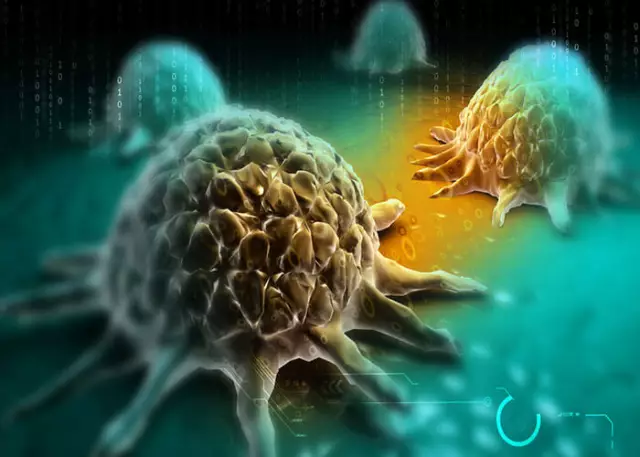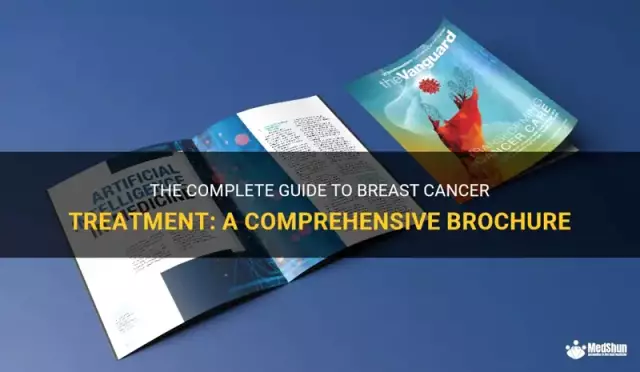- Author Rachel Wainwright [email protected].
- Public 2023-12-15 07:39.
- Last modified 2025-11-02 20:14.
Testicular cancer
General characteristics of the disease

Testicular cancer is one of the rarest pathologies. In the general statistics of oncological diseases, signs of testicular cancer are diagnosed in no more than 2% of patients. At the same time, the disease is extremely aggressive: among men under 35 years of age, testicular cancer is one of the most common causes of early death of oncological etiology.
In a third of cases, signs of testicular cancer are diagnosed in male children. In 90% of cases, the cause of testicular cancer in boys under 3 years old is the malignancy of a benign tumor - teratoma. It occurs due to violations of the development of the intrauterine period.
Causes of testicular cancer in adult men include scrotal trauma, endocrine system pathology, radiation exposure, and cryptorchidism. This congenital anomaly associated with the undescended testicle into the scrotum, without timely treatment, also threatens to turn into testicular cancer.
Signs of testicular cancer are 5 times more common in men of European descent. The highest incidence of diagnosed testicular cancer today is recorded in Scandinavia and Germany, the lowest in Asian countries and the states of the African continent.
Testicular cancer symptoms
A reliable symptom of testicular cancer is the appearance of a nodule against the background of simultaneous tissue compaction and organ enlargement. The scrotum in testicular cancer also increases in size and swells. As the tumor grows, the man experiences pain from the testicle and spermatic cord.
A symptom of testicular cancer with retroperitoneal lymph nodes is abdominal pain. With further growth of the tumor, there is a massive increase in lymph nodes, back pain, shortness of breath, shortness of breath, weakness. Symptoms of testicular cancer with dropsy of the membranes of the testicles are often similar to the clinical picture of epididymo-orchitis - a combination of inflammation of the testicles and epididymis. With hormonal activity of the tumor, testicular cancer leads to changes in secondary sexual characteristics: gynecomastia (breast enlargement), premature puberty, hirsutism (early hair growth) in boys.
Testicular Cancer Diagnosis
The first step in the diagnosis of testicular cancer is palpation of both testicles of the patient. After that, the groin lymph nodes are palpated, as well as an examination of the breast to exclude gynecomastia.
The next step in the diagnosis of testicular cancer is the use of diaphanoscopy (scanning the scrotum with a cytoscope). This diagnostic method distinguishes a fluid-filled cyst from a solid body of a benign tumor or testicular cancer. Laboratory methods for detecting the symptoms of testicular cancer include clinical, immunochemical, and biochemical blood and urine tests.
The definitive diagnosis of testicular cancer is based on the results of a biopsy of testicular tissue. Examination of a biopsy under a microscope can determine the type of tumor and predict the expected rate of development of testicular cancer.

The abdomen of a patient with signs of testicular cancer is examined using an ultrasound scan. Chest x-rays, MRI, and CT are done to determine the extent of testicular cancer metastasis.
Testicular cancer stages
Stage I testicular cancer is characterized by localization of the tumor within the organ and the absence of metastases.
A sign of stage II testicular cancer is the presence of tumor metastases in the retroperitoneal lymph nodes.
At III and IV stages of testicular cancer, there are already metastases to distant lymph nodes.
Clinical TNM-classification of testicular cancer and other oncological diseases is no less popular in medical circles. "T" from 1 to 4 characterizes the tumor itself, "N" describes the state of regional lymph nodes, "M" with a coefficient "0" indicates the absence of distant metastases, and M1 - the presence of distant metastases.
Testicular cancer treatment
Treatment of testicular cancer is complex. It consists in the removal of the tumor focus, in the preventive and therapeutic resection of the lymph nodes, as well as in the systemic chemotherapy effect on atypical cells.
Surgical treatment of testicular cancer involves the complete removal of the affected organ along with the epididymis - orchiectomy or hemicastration. If metastases of testicular cancer are found in the peritoneal space, retroperitoneal lymphadenectomy is also performed - removal of the nearest lymph nodes and revision of all organs of the abdominal cavity.
After the operation and recovery period, the patient with testicular cancer is referred for chemotherapy and radiotherapy. Chemotherapy for testicular cancer is systemic. It is administered through intravenous injection or pills and affects the entire body. But since testicular cancer cells or tumors of other localization have the highest metabolic rate, they are the first to be destroyed.
Radiation exposure in the treatment of testicular cancer is a local type of therapy. If the tumor is large in stage III-IV testicular cancer, it can be used at the preoperative stage. After surgery, radiation treatment for testicular cancer is used to treat lymph node and bone metastases.
YouTube video related to the article:
The information is generalized and provided for informational purposes only. At the first sign of illness, see your doctor. Self-medication is hazardous to health!






